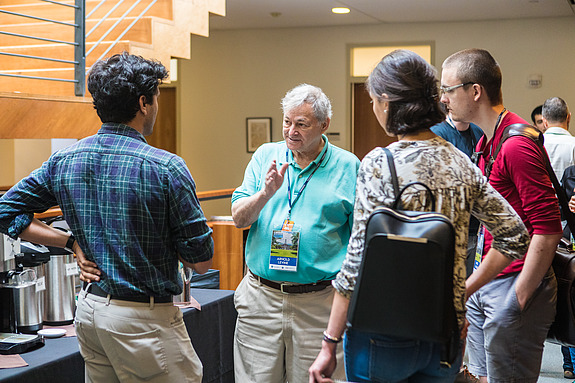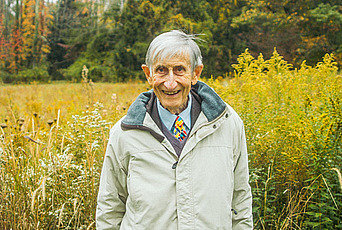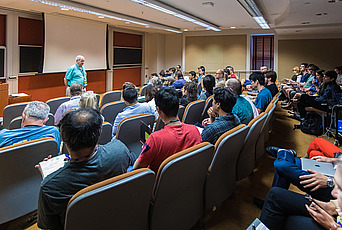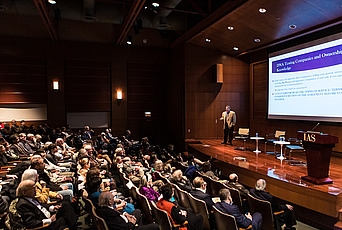Seventy Years and Two Paradigm Shifts: The Changing Faces of Biology

In the summer of 1968, a young, newly minted assistant professor moved from a postdoctoral position at Caltech to Princeton University. Schooled and trained over the previous seven years in the reductionist approaches of Watson and Cricks’ molecular biology, he moved into the Moffett Laboratory to study how the simplest of organisms, a virus, could cause cancer in a mouse or in a hamster. Among the questions under study in the laboratory were: how many genes did the virus devote to causing cancer? How did the proteins encoded by these genes function to initiate and to maintain a tumor? What were the molecular mechanisms involved? The Moffett laboratory building was a newer extension to Guyot Hall, which had been built in 1909 for the Geology and (then) newly created Biology Department.
A great deal of the space at the entrance of the building was taken up with stuffed animals, jars filled with formalin containing suspended embryos, skeletons of animals that no longer exist, and plants imprinted into rocks millions of years ago. Plates that Audubon used to etch images of his birds and print his beautiful books hung on the walls. The diversity and varieties of animals selected by Darwinian evolution over the geological ages were in evidence, extolling the unity of all organisms and the central tenets of geology and biology. It was a great biological museum, dedicated to a biology that began in 1859, when Darwin published his book On the Origin of Species, and stretched to 1953, when Watson and Crick published a paper on the structure of DNA. From 1953 to 1968, a generation of young biologists were passing through Thomas Kuhn’s paradigm shift from organismic biology, celebrated in the Guyot museum, to molecular biology, viewing life at the molecular level and asking questions that often ignored the organism, its natural life cycle, and its interactions with the environment. The new molecular biologists would look forward to the sequences of those chemicals that made up DNA as the proper study of evolution.
Watson and Crick (1953) built a model of DNA using Rosalind Franklin’s X-ray data and Erwin Chargaff’s rules. That model made two clear predictions: The double helix would replicate in a semi-conservative fashion, separating the two parental strands of DNA, which could then act as templates using base pairing. This was demonstrated to be the case in 1958 (Meselson and Stahl). Second, the sequence of nucleotides (the basic building blocks of DNA and RNA, consisting of a nitrogenous base, a five-carbon sugar, and at least one phosphate group) in the DNA polymer contained information, a genetic code, determining the sequences of amino acids in proteins and, eventually, the structure and the function of the protein. The first codon (UUU=phenylalanine) was elucidated in 1961 (Nirenberg and Matthaei). The founders of molecular biology employed the simplest of organisms: bacteria and their viruses, using the tools of genetics, models of molecular circuits in a cell, and they invented new methods that were required to explore DNA, RNA, and proteins at the molecular level.
This paradigm shift came with many levels of change. The molecular biologists were often blue-collar workers, toiling in the laboratory day and night seven days a week. Pipetting was repetitive and experiments were hard and didn’t work unless you got it right. And if it was right, it had to be reproducible every time. The first molecular biologists to arrive at Princeton (1965–75) trained at Stanford, Berkeley, the Pasteur Institute, Geneva, Cambridge (England), and Caltech rather than the Ivy League Schools that produced many of the senior professors in the department. They liked Bob Dylan and rock music and hated the Vietnam war, rebelling against their countries’ decisions, voting to bring women into the Ivy League Schools (Princeton accepted female undergraduates in 1969), and taking time to listen to the few black students at the University discuss issues of equality.
The molecular biologists liked the June through September break in the school year, and they stayed in the laboratory or attended meetings at Cold Spring Harbor. Most senior faculty spent the summer at Woods Hole, while others wrote books in secluded summer homes. There was a whiff of arrogance about the molecular biologists. They were convinced that they would change our understanding of life and life processes, and thereby change the world. They were not all wrong.
By the 1970s genes were cloned and isolated and the sequences of the nucleotides revealed the proteins that they made, which could then be expressed and produced in bacteria. Change was coming rapidly but not without fear and objections and hotly contested questioning about the safety of moving genes around into new species. A common question was “What does one learn from all this reductionism without the organism?” Jacques Monod’s answer was “What is true for E. coli is true for the elephant.” The response referred to the parable of a blind man examining an elephant: you study the tail or the trunk and that is all there is and that is all you know. There was a tension about what biology departments of the future would look like. What were the right subjects to teach the next generation? and what approach to biology would be given the space and the money to take the future?
These questions were played out in interesting and often complicated ways. In biology and biochemistry at Princeton, the first-year graduate students met in a class setting to discuss how a researcher chooses his or her research problem to start a laboratory. This discussion was a way to introduce each faculty member to the first-year class, discuss the science carried out by the faculty, and have lots of time to explore how and why the faculty decide the paths of their research questions. The class was held in the evening, and two faulty members were paired so that the students would hear two points of view and diverse ideas.
One year, I was paired with the Chairman of the Biology Department, John Tyler Bonner. John was a gifted scientist and a true gentleman, the kind of chairman everyone respected. He had attended Harvard University for his studies, working on the biology of the cellular slime mold, Dictyostelium discodeum. In solving his thesis problem on this slime mold, he had made a real breakthrough in his thesis problem, demonstrating that an important part of the life cycle of Dictyostelium discodeum employed a chemotactic factor to create a fused multicellular structure from single cell amoeba. At Princeton, John had demonstrated that the chemical signal that initiates aggregation of cells was cyclic AMP. These organisms are at the evolutionary transition of single cells to multicellular organisms.

On the evening of our discussion with the graduate students, John spoke first, telling the students how and why he had worked his entire career on this slime mold. He started by outlining the life cycle of this mold. A large number of single cell amoeba in a pond or in a petri dish (in the lab) swim and crawl around eating bacteria, which serves as their food source. They can reproduce asexually as amoeba. When they run out of bacteria, a chemotactic signal begins in some amoeba that attracts other amoeba, fusing into a giant zygote cell. The fusion of lots of amoeba initiates a sexual cycle (these molds have three sexes), and the macrocyst that forms diploid nuclei undergoes meiosis, which is followed by mitosis. As bacteria repopulate the environment, haploid amoeba are released from the macrocyst to feed and reproduce asexually, beginning the next life cycle. John stressed that he was intrigued by the events and complexity of the life cycle and its interaction with environmental clues for development. He pointed out that he had worked on this organism as an undergraduate, graduate student, and faculty member, all his scientific life, and would continue doing so because many questions remained to be studied. It was clear from his description of these events that he was deeply committed to this work and this organism. It was a compelling presentation.
It was now my turn to present the research questions my laboratory investigated. I started by pointing out that even as a high school student I was fascinated by viruses; they were so simple. The virus I worked with at Princeton had only six genes, yet it had a program to replicate itself in a cell, by borrowing some cellular functions. What were the functions of the viral and cellular genes that had this ability to duplicate themselves by taking over the cell? But more, when this virus was injected into newborn hamsters, it often caused a cancer to grow some six to nine months later. Every cancer cell had a copy of the viral DNA integrated into a cellular chromosome, and that integrated viral DNA expressed a subset of the virus-encoded proteins. I wanted to figure out what genes and their proteins replicated this virus, and what genes and their proteins caused the cancer, and how they functioned to make a tumor. And when I figured this out, I would move on to another organism and another research problem.
I think both John and I were aware of the differences in our philosophies of doing research, and that we were what we were and could not be anything else. But it was good for the students to be exposed to different ideas, approaches, and levels of analysis. Although my exposure and training were all at the molecular level, it was good for me, as a research scientist, to be exposed to organismic biology, evolutionary biology, and ecology. I am not so sure it was as easy to be a senior chairman and professor when young researchers with all the answers came to town. To quote John, from his book Biology at Princeton (1947–2012), a history of the department, from a chapter called “The Molecular Wars” he notes that the opinions of molecular biologists were “all of biology must now be subsumed under molecular biology. All of the people working on any other form of biology were barking up the wrong tree; that tree was all dead wood.” Princeton, of course, was not the only University to live through these times of change, and most schools, like Princeton, solved the problem by forming two departments of biology, one called “Ecology and Evolution” and the other “Molecular Biology.” Today both departments contribute and flourish.
Ironically, that is not the end of this story. As the last thirty years of the twentieth century progressed, new technologies were developed that permitted examination of the transcription levels of thousands of genes in a group of cells and all the transcripts in a single cell. The sequencing of larger genomes culminated in the sequence of the human genome in 2001. Today, we do study evolution by sequencing and studying thousands of genomes from different organisms. We follow the relationships and evolutionary changes of genes over time and in novel organisms; we construct new trees of life forms; and we observe new processes of evolutionary change. DNA contains many diverse types of information that we need to understand.
Watch videos from the 2019 Prospects in Theoretical Physics program, “Great Problems in Biology for Physicists,” here.
A deeper explanation of how genotypes are translated into phenotypes has begun. The exploration of how gene functions, organisms, and populations respond to a changing environment over a billion years is under study. We have explored the origins of humans in Africa, their migrations and formation of racial groups over hundreds of thousands of years. We study epidemics and pandemics by sequencing infectious agents over time scales of hundreds of years. The study of viruses that cause cancer in animals has led to the discovery of oncogenes and tumor suppressor genes that cause cancers in humans. Many investigators have now stopped their studies with viruses and instead focused on the gene functions and the mutations that cause human cancers. Cancer, like evolution, presents us with combinatorial changes of genes in a genome. We have assembled vast datasets of information and need to extract meaning from them. We now find that the average molecular biologist does not have the quantitative skills to handle these large datasets, extract information from them, and translate that information into the behavior and form of the organism. The study of life is becoming the elucidation of information storage and organization, information read out, stability and repair, and the selective use of information in response to reproductive requirements, nutrient use, and environmental stresses.
The current shift is back to integrative or systems biology, which is being populated by individuals trained in physics, computer sciences, mathematics, and engineering, who learn biology and work with biologists who can test their ideas in a laboratory or even the clinic. This process of collaborative science, termed “convergence” by Phil Sharp, is starting to populate universities, medical schools, and research institutes.
Topological applications are being applied to datasets to classify the shapes of information that populate different datasets. Information theory is being applied to signal transduction (the process by which a chemical or physical signal is transmitted through a cell as a series of molecular events, e.g. protein phosphorylation resulting in a cellular response) so as to determine which genes contain the maximum entropy (a measure of the information, or connections) in a cellular network. Neural networks are being designed for biological questions and to permit machine learning to explore associations and patterns not previously identified. Machine learning is creating new technologies that will change how we do biology. There are undergraduate and graduate programs in biology that are demanding quantitative skills in mathematics or computer science not practiced at present in the field of molecular biology. Scientists trained in physics or computer science are taking postdoctoral positions to learn biology and apply their skills to biological questions. Time will tell what the impact of these fusions of disciplines will lead to and the directions to be taken by biological questions.
Throughout the twentieth century physicists and mathematicians have come into biology, and some have made a considerable impact. Mostly, this pattern of convergence has not persisted. Will it be different this time? Will it become a branch of biology? Will systems biology replace molecular biology as the most common approach to biological questions? The questions to be explored are now extraordinary and the depth of information to explore them has never been greater, so the attraction of young scientists to the biological sciences is clear. The very tools created by the molecular biologists of the late twentieth and early twenty-first centuries have sparked a revolution of biological information that now needs to be analyzed and understood. This will require a new skill set. The tools of biology will blend with computer sciences, physics, and mathematics, and the practitioners of biology will undergo another paradigm shift.
To have lived through one paradigm shift in biology is demanding; to go through two such changes is a testament to the progress that science is making and the pace of change.


